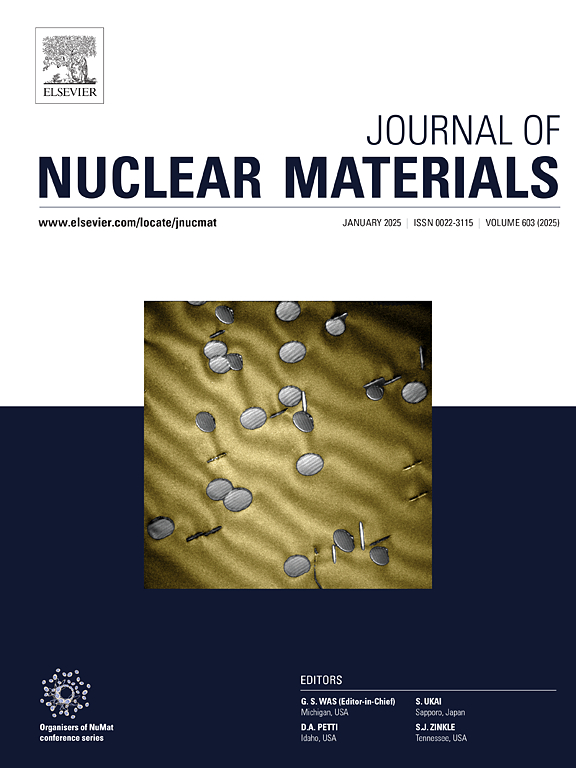Assessment of Ni and Mn effect on the irradiation hardening behavior of VVER-1000 model steels exposed to high fluences in the high flux reactor
IF 3.2
2区 工程技术
Q3 MATERIALS SCIENCE, MULTIDISCIPLINARY
引用次数: 0
Abstract
In the present work, we aim at providing more data and insight related to the influence of Ni and Mn contents on the degree of irradiation hardening of Light Water Reactor RPV steels. A total of 20 model steels and realistic welds based on VVER-1000 and PWR RPVs compositions were irradiated at high flux and to high fluences in the LYRA-10 experiment, conducted in the High Flux Reactor, Petten. Among them, eight VVER-1000 model steels with 0.1 wt % Cu and systematically varied Mn and Ni contents were submitted to tensile and Vickers hardness testing for evaluation of their degree of hardening, and were characterized in detail, using Atom Probe Tomography, Transmission Electron Microscopy, Small Angle Neutron Scattering and Positron Annihilation Spectroscopy. The mechanical testing results show the clear increase in degree of irradiation hardening with the Mn and Ni contents, in particular for steels containing 1.4 wt % Mn. Microstructural observations show direct correlation between increase in yield strength and the formation of Mn-Ni-Si solute clusters. Calculations done using classic and multiscale models confirm that the solute clusters are the main hardening features present in the irradiated RPV model steels. Furthermore, TEM and PAS results suggest that dislocation loops have a more significant role on the formation of solute clusters than on irradiation hardening of the group of materials investigated.
Ni和Mn对VVER-1000模型钢在高通量反应堆中高通量辐照硬化行为影响的评估
在目前的工作中,我们的目的是提供更多的数据和见解有关Ni和Mn含量对轻水反应堆RPV钢辐照硬化程度的影响。在Petten的高通量反应堆中进行的LYRA-10实验中,基于VVER-1000和PWR RPVs成分的总共20种模型钢和实际焊缝进行了高通量和高通量辐照。其中,8个Cu含量为0.1 wt %, Mn和Ni含量系统变化的VVER-1000模型钢进行了拉伸和维氏硬度测试,以评估其硬化程度,并使用原子探针断层扫描、透射电子显微镜、小角中子散射和正电子湮没光谱对其进行了详细的表征。力学试验结果表明,随着Mn和Ni含量的增加,特别是Mn含量为1.4 wt %的钢的辐照硬化程度明显增加。显微结构观察表明,屈服强度的提高与Mn-Ni-Si溶质团簇的形成有直接关系。使用经典模型和多尺度模型进行的计算证实,溶质团簇是辐照RPV模型钢中存在的主要硬化特征。此外,TEM和PAS结果表明,位错环对溶质团簇形成的影响比对辐照硬化的影响更大。
本文章由计算机程序翻译,如有差异,请以英文原文为准。
求助全文
约1分钟内获得全文
求助全文
来源期刊

Journal of Nuclear Materials
工程技术-材料科学:综合
CiteScore
5.70
自引率
25.80%
发文量
601
审稿时长
63 days
期刊介绍:
The Journal of Nuclear Materials publishes high quality papers in materials research for nuclear applications, primarily fission reactors, fusion reactors, and similar environments including radiation areas of charged particle accelerators. Both original research and critical review papers covering experimental, theoretical, and computational aspects of either fundamental or applied nature are welcome.
The breadth of the field is such that a wide range of processes and properties in the field of materials science and engineering is of interest to the readership, spanning atom-scale processes, microstructures, thermodynamics, mechanical properties, physical properties, and corrosion, for example.
Topics covered by JNM
Fission reactor materials, including fuels, cladding, core structures, pressure vessels, coolant interactions with materials, moderator and control components, fission product behavior.
Materials aspects of the entire fuel cycle.
Materials aspects of the actinides and their compounds.
Performance of nuclear waste materials; materials aspects of the immobilization of wastes.
Fusion reactor materials, including first walls, blankets, insulators and magnets.
Neutron and charged particle radiation effects in materials, including defects, transmutations, microstructures, phase changes and macroscopic properties.
Interaction of plasmas, ion beams, electron beams and electromagnetic radiation with materials relevant to nuclear systems.
 求助内容:
求助内容: 应助结果提醒方式:
应助结果提醒方式:


